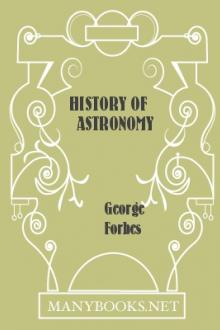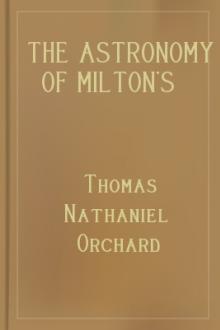History of Astronomy by George Forbes (classic children's novels TXT) 📕

- Author: George Forbes
- Performer: -
Book online «History of Astronomy by George Forbes (classic children's novels TXT) 📕». Author George Forbes
Now, by the refined parallax determinations of Gill at the Cape, we know that of Sirius to be 0”.38. From this it has been calculated that the mass of Sirius equals two of our suns, and its intrinsic brightness equals twenty suns; but the companion, having a mass equal to our sun, has only a five-hundredth part of the sun’s brightness.
Spectroscopic Binaries.—On measuring the velocity of a star in the line of sight at frequent intervals, periodic variations have been found, leading to a belief in motion round an invisible companion. Vogel, in 1889, discovered this in the case of Spica (alpha Virginis), whose period is 4d. 0h. 19m., and the diameter of whose orbit is six million miles. Great numbers of binaries of this type have since then been discovered, all of short period.
Also, in 1889, Pickering found that at regular intervals of fifty-two days the lines in the spectrum of zeta of the Great Bear are duplicated, indicating a relative velocity, equal to one hundred miles a second, of two components revolving round each other, of which that apparently single star must be composed.
It would be interesting, no doubt, to follow in detail the accumulating knowledge about the distances, proper motions, and orbits of the stars; but this must be done elsewhere. Enough has been said to show how results are accumulating which must in time unfold to us the various stellar systems and their mutual relationships.
Variable Stars.—It has often happened in the history of different branches of physical science that observation and experiment were so far ahead of theory that hopeless confusion appeared to reign; and then one chance result has given a clue, and from that time all differences and difficulties in the previous researches have stood forth as natural consequences, explaining one another in a rational sequence. So we find parallax, proper motion, double stars, binary systems, variable stars, and new stars all bound together.
The logical and necessary explanation given of the cause of ordinary spectroscopic binaries, and of irregular proper motions of Sirius and Procyon, leads to the inference that if ever the plane of such a binary orbit were edge-on to us there ought to be an eclipse of the luminous partner whenever the non-luminous one is interposed between us. This should give rise either to intermittence in the star’s light or else to variability. It was by supposing the existence of a dark companion to Algol that its discoverer, Goodricke of York,[16] in 1783, explained variable stars of this type. Algol (beta Persei) completes the period of variable brightness in 68.8 hours. It loses three-fifths of its light, and regains it in twelve hours. In 1889 Vogel,[17] with the Potsdam spectrograph, actually found that the luminous star is receding before each eclipse, and approaching us after each eclipse; thus entirely supporting Goodricke’s opinion. There are many variables of the Algol type, and information is steadily accumulating. But all variable stars do not suffer the sudden variations of Algol. There are many types, and the explanations of others have not proved so easy.
The Harvard College photographs have disclosed the very great prevalence of variability, and this is certainly one of the lines in which modern discovery must progress.
Roberts, in South Africa, has done splendid work on the periods of variables of the Algol type.
New Stars.—Extreme instances of variable stars are the new stars such as those detected by Hipparchus, Tycho Brahe, and Kepler, of which many have been found in the last half-century. One of the latest great “Novæ” was discovered in Auriga by a Scotsman, Dr. Anderson, on February 1st, 1892, and, with the modesty of his race, he communicated the fact to His Majesty’s Astronomer for Scotland on an unsigned post-card.[18] Its spectrum was observed and photographed by Huggins and many others. It was full of bright lines of hydrogen, calcium, helium, and others not identified. The astounding fact was that lines were shown in pairs, bright and dark, on a faint continuous spectrum, indicating apparently that a dark body approaching us at the rate of 550 miles a second[19] was traversing a cold nebulous atmosphere, and was heated to incandescence by friction, like a meteor in our atmosphere, leaving a luminous train behind it. It almost disappeared, and on April 26th it was of the sixteenth magnitude; but on August 17th it brightened to the tenth, showing the principal nebular band in its spectrum, and no sign of approach or recession. It was as if it emerged from one part of the nebula, cooled down, and rushed through another part of the nebula, rendering the nebular gas more luminous than itself.[20]
Since 1892 one Nova after another has shown a spectrum as described above, like a meteor rushing towards us and leaving a train behind, for this seems to be the obvious meaning of the spectra.
The same may be said of the brilliant Nova Persei, brighter at its best than Capella, and discovered also by Dr. Anderson on February 22nd, 1901. It increased in brightness as it reached the densest part of the nebula, then it varied for some weeks by a couple of magnitudes, up and down, as if passing through separate nebular condensations. In February, 1902, it could still be seen with an opera-glass. As with the other Novæ, when it first dashed into the nebula it was vaporised and gave a continuous spectrum with dark lines of hydrogen and helium. It showed no bright lines paired with the dark ones to indicate a train left behind; but in the end its own luminosity died out, and the nebular spectrum predominated.
The nebular illumination as seen in photographs, taken from August to November, seemed to spread out slowly in a gradually increasing circle at the rate of 90” in forty-eight days. Kapteyn put this down to the velocity of light, the original outburst sending its illumination to the nebulous gas and illuminating a spherical shell whose radius increased at the velocity of light. This supposition seems correct, in which case it can easily be shown from the above figures that the distance of this Nova was 300 light years.
Star Catalogues.—Since the days of very accurate observations numerous star-catalogues have been produced by individuals or by observatories. Bradley’s monumental work may be said to head the list. Lacaille’s, in the Southern hemisphere, was complementary. Then Piazzi, Lalande, Groombridge, and Bessel were followed by Argelander with his 324,000 stars, Rumker’s Paramatta catalogue of the southern hemisphere, and the frequent catalogues of national observatories. Later the Astronomische Gesellschaft started their great catalogue, the combined work of many observatories. Other southern ones were Gould’s at Cordova and Stone’s at the Cape.
After this we have a new departure. Gill at the Cape, having the comet 1882.ii. all to himself in those latitudes, wished his friends in Europe to see it, and employed a local photographer to strap his camera to the observatory equatoreal, driven by clockwork, and adjusted on the comet by the eye. The result with half-an-hour’s exposure was good, so he tried three hours. The result was such a display of sharp star images that he resolved on the Cape Photographic Durchmusterung, which after fourteen years, with Kapteyn’s aid in reducing, was completed. Meanwhile the brothers Henry, of Paris, were engaged in going over Chacornac’s zodiacal stars, and were about to catalogue the Milky Way portion, a serious labour, when they saw Gill’s Comet photograph and conceived the idea of doing the rest of their work by photography. Gill had previously written to Admiral Mouchez, of the Paris Observatory, and explained to him his project for charting the heavens photographically, by combining the work of many observatories. This led Admiral Mouchez to support the brothers Henry in their scheme.[21] Gill, having got his own photographic work underway, suggested an international astrographic chart, the materials for different zones to be supplied by observatories of all nations, each equipped with similar photographic telescopes. At a conference in Paris, 1887, this was decided on, the stars on the charts going down to the fourteenth magnitude, and the catalogues to the eleventh.
[Illustration: GREAT COMET, Nov. 14TH, 1882. (Exposure 2hrs. 20m.) By kind permission of Sir David Gill. From this photograph originated all stellar chart-photography.]
This monumental work is nearing completion. The labour involved was immense, and the highest skill was required for devising instruments and methods to read off the star positions from the plates.
Then we have the Harvard College collection of photographic plates, always being automatically added to; and their annex at Arequipa in Peru.
Such catalogues vary in their degree of accuracy; and fundamental catalogues of standard stars have been compiled. These require extension, because the differential methods of the heliometer and the camera cannot otherwise be made absolute.
The number of stars down to the fourteenth magnitude may be taken at about 30,000,000; and that of all the stars visible in the greatest modern telescopes is probably about 100,000,000.
Nebulæ and Star-clusters.—Our knowledge of nebulæ really dates from the time of W. Herschel. In his great sweeps of the heavens with his giant telescopes he opened in this direction a new branch of astronomy. At one time he held that all nebulæ might be clusters of innumerable minute stars at a great distance. Then he recognised the different classes of nebulæ, and became convinced that there is a widely-diffused “shining fluid” in space, though many so-called nebulæ could be resolved by large telescopes into stars. He considered that the Milky Way is a great star cluster, whose form may be conjectured from numerous star-gaugings. He supposed that the compact “planetary nebulæ” might show a stage of evolution from the diffuse nebulæ, and that his classifications actually indicate various stages of development. Such speculations, like those of the ancients about the solar system, are apt to be harmful to true progress of knowledge unless in the hands of the ablest mathematical physicists; and Herschel violated their principles in other directions. But here his speculations have attracted a great deal of attention, and, with modifications, are accepted, at least as a working hypothesis, by a fair number of people.
When Sir John Herschel had extended his father’s researches into the Southern Hemisphere he was also led to the belief that some nebulae were a phosphorescent material spread through space like fog or mist.
Then his views were changed by the revelations due to the great discoveries of Lord Rosse with his gigantic refractor,[22] when one nebula after another was resolved into a cluster of minute stars. At that time the opinion gained ground that with increase of telescopic power this would prove to be the case with all nebulæ.
In 1864 all doubt was dispelled by Huggins[23] in his first examination of the spectrum of a nebula, and the subsequent extension of this observation to other nebulæ; thus providing a certain test which increase in the size of telescopes could never have given. In 1864 Huggins found that all true nebulae give a spectrum of bright lines. Three are due to





Comments (0)